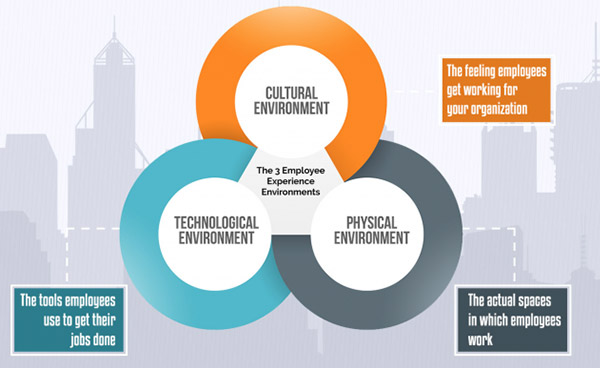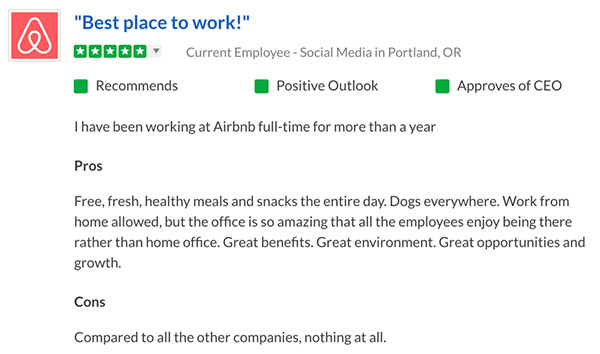How Great Employee Experience Influences Customer Experience

Last updated on July 9, 2024
We hear a lot about customer experience and user experience. Companies are competing to provide amazing customer experiences, from the first interaction to the last interaction. Everyone from marketing to product development and support are involved, and it takes a lot of work to get it right.
But what about employee experience? How does it feel to work for your company? Is it overall a positive, seamless, and rewarding experience? Or is it a toxic culture full of friction and negativity?
Customer experience has gotten attention for many years, but organizations are starting to realize the key to a world-class customer experience is nailing the employee experience first. After all, satisfied employees are more likely to create satisfied customers.
What is Employee Experience?
Denise Lee Yohn, author of FUSION: How Integrating Brand and Culture Powers the World’s Greatest Companies defines “employee experience” as the following:
Employee experience is the sum of everything an employee experiences throughout his or her connection to the organization — every employee interaction, from the first contact as a potential recruit to the last interaction after the end of employment.
As you can see, there are a lot of similar characteristics between customer experience and employee experience. In fact, the same definition works if you replace the word “employee” with “customer”:
Customer experience is the sum of everything a customer experiences throughout his or her connection to the organization — every customer interaction, from the first contact as a potential customer to the last interaction…
Customer experience is the perception a customer has of your organization, whereas employee experience is the perception an employee has of your organization. Both are important for attracting and retaining customers and employees.
A good employee experience promotes the success of the employees, not just the success of the company. That means providing the tools, environment, and culture for the organization’s employees to do their jobs to the best of their abilities. When employees win, customers win, and when customers win, the organization succeeds.
A study done by GrantThorton found that companies with healthy cultures are 1.5 times more likely to report average revenue growth of more than 15% for the past three years.
Employee experience is not just culture or engagement
Employee experience is more than a nice office and engaged employees. A modern, clean office with a stocked refrigerator, kombucha, and a ping-pong table is great, but you need more than that to round out the entire employee experience. What’s a fancy office if employees are stuck using out-dated clunky equipment or feeling trapped under a toxic manager?
Friendly people, office parties, and company retreats bring a lot of value to the employee experience, but these things alone don’t equal a good employee experience. These things are only a piece of the whole picture.
It takes all of these things (culture, environment, and tools) to create an amazing employee experience from end-to-end. If you’re doing two of these really well, you have work to do. It takes focus in each of these areas to really create an employee experience where people want to show up to work.
A shift in thinking
Organizations that get employee experience right are the ones figuring out how to make it so people want to show up to work. This isn’t how it’s always been though. There’s been a big shift in thinking over time.
The old school mentality is assuming that people need to come to work because they need a job. When organizations think like that, they provide the bare minimum for employees to get their work done.
Winning companies are shifting away from that way of thinking, and they’re creating places where people want to be. This is especially important as the average tenure of employees continues to decrease. Employers are challenged to figure out how to keep their employees. Employees who have a choice in when, where, and how they work have higher levels of satisfaction, innovation, and job performance, according to the Harvard Business Review.
This comes down to much more than office space (whether it’s home office or public) and culture. It requires dialing in the entire employee experience and everything that goes into how an employee interacts with an organization: from submitting an application, showing up to work, working with your team, and participating in an exit interview.
The three elements of employee experience

Cultural environment: Company culture is perhaps the most talked-about element of employee experience today. It is effectively how it feels to work for an organization; the overall vibe of the company. It includes things like organizational structure, leadership style, compensation and benefits, volunteer days, remote friendliness and company values.
Physical space: Office spaces have transformed drastically over the years. From stuffy cubicles to open office spaces, the spaces where we do our work have a massive influence on our experience day-to-day. This includes things like the office location and layout, and amenities available to employees such as a kitchen, gym, and bike parking. You might even offer employees the chance to work from home, giving them more ownership over their work environment.
Tools: There is an endless number of workplace productivity tools available today. These are the tools that allow us to do our jobs. Some of them are great, some of them are horrible. They include things like our computers, phones, email systems, project management tools, collaboration and scheduling tools, recruiting tools and so much more.
Why employee experience is important
Just as outstanding customer experiences are pivotal in retaining customers, exceptional employee experiences begin with recruitment and are fundamental in retaining staff. Hiring new employees is not only costly but also time-consuming, akin to acquiring and onboarding new customers. Implementing a robust Customer Relationship Management (CRM) system and an Employer of Record service for recruitment can streamline this process, enhancing the initial employee experience. Maintaining the interest and engagement of existing employees through incredible employee experiences is crucial for the prosperity of any company.
The Employee Experience Index sums this up quite well:
Our research reveals that employees who experience a sense of belonging, purpose, achievement, happiness and vigor are more likely to perform at higher levels and contribute “above and beyond” expectations. They are also less likely to quit.
Focusing on the employee experience also helps organizations attract new talent. We’ve all heard nightmare stories about company X being a terrible place to work. Don’t be that company. Be the opposite. Be the company known for an amazing workplace experience and you’ll have people knocking at your door to come work for you. Your recruiting team will thank you!
It’s easier than ever to learn about a given company’s employee experience. Websites like Glassdoor, LinkedIn and even Twitter shed plenty of light on what it’s like to work for a given organization.

Improving your Employee Experience
Building a world-class employee experience takes time and money. It’s an investment in not only your employees but your company’s success. Leading companies are hiring dedicated roles and teams that focus on employee experience, and there are events and books focused on this topic. Culture Amp recommends four steps to getting started with employee experience:
- Determine your top priority: Identify which part of the employee experience your company needs to focus on.
- Start capturing data: Collect data such as eNPS (Employee Net Promoter Score) to help measure where the items in the top priority currently are.
- Build-in linkages from the beginning: Design surveys based on existing feedback, and let future surveys inform each following survey.
- Empower action: Share the feedback with leadership and hiring managers so they can make changes to the employee experience.
Conclusion
By providing the right combination of tools, culture and environment, you’ll be able to dial in a unique employee experience where people want to work with your organization. As you continue to build a team of satisfied employees, this satisfaction will trickle into the customers, and that’s when you’ll really win!
Today’s leading companies are cracking the code to figure out how to not only attract, but retain employees. If you’ve figured out how to make people want to show up to work day after day, you’ve nailed the employee experience.
It doesn’t stop there though. Continue gathering feedback from people who work at your organization and make regular modifications and improvements. Consider creating engaging training videos with the help of one of the best text-to-speech tools, enhancing the learning experience for your team. This approach allows you to compete effectively with others. Invest in your employee experience just as you invest in your customer experience: through research and insights, tools, internal trainings, culture, and providing an overall thriving and exciting place to work.
